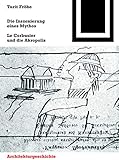Die Inszenierung eines Mythos : Le Corbusier und die Akropolis / Turit Fröbe.
Material type: TextSeries: Bauwelt Fundamente ; 157Publisher: Basel : Birkhäuser, [2016]Copyright date: ©2016Description: 1 online resource (260 p.)Content type:
TextSeries: Bauwelt Fundamente ; 157Publisher: Basel : Birkhäuser, [2016]Copyright date: ©2016Description: 1 online resource (260 p.)Content type: - 9783035611182
- 9783035608991
- 9783035609134
- NA680
- online - DeGruyter
| Item type | Current library | Call number | URL | Status | Notes | Barcode | |
|---|---|---|---|---|---|---|---|
 eBook
eBook
|
Biblioteca "Angelicum" Pont. Univ. S.Tommaso d'Aquino Nuvola online | online - DeGruyter (Browse shelf(Opens below)) | Online access | Not for loan (Accesso limitato) | Accesso per gli utenti autorizzati / Access for authorized users | (dgr)9783035609134 |
Frontmatter -- Inhalt -- Prolog -- Einleitung -- I. Die Akropolis in „Vers une Architecture“ -- II. „Vers une Architecture“: der Bezugsrahmen von Le Corbusiers Akropolis-Rezeption -- III. Die Entdeckung der Akropolis 1908 –1914 -- IV. Aus Jeanneret wird Le Corbusier 1918–1923 -- V. Die Akropolis-Idee in Le Corbusiers architektonischen und städtebaulichen Entwürfen -- VI. Ausblick: Die Rezeption der Rezeption -- Epilog -- Anmerkungen -- Literaturverzeichnis -- Abbildungsverzeichnis
restricted access online access with authorization star
http://purl.org/coar/access_right/c_16ec
Die Akropolis ist in Le Corbusiers Werk allgegenwärtig. Sie war Inspirationsquelle, Prüfstein für die eigene Architektur und Maßstab für die eigenen Ansprüche. Sie war aber auch zentraler Bestandteil seiner Selbstinszenierung und trug zur erfolgreichen Gründung des Mythos Le Corbusier bei. Turit Fröbe nimmt eine Neubewertung der Rolle der Akropolis für Le Corbusiers Werk jenseits seiner eigenen Narration vor. Sie rekonstruiert seine Auseinandersetzung mit dem Monument, stellt dar, welcher Quellen er sich bediente und zeigt, was er darüber hinaus an Erfahrungen ganz anderen Ursprungs unter dem Stichwort Akropolis subsumierte. Das Ergebnis war eine Rezeption, die eigenständig und eigenwillig und dabei dennoch fest verankert in der Tradition des 19. und des 20. Jahrhunderts war.
The Acropolis is a leitmotif in the works of Le Corbusier: it was a central element of his self-presentation, and contributed to the success of the myth that surrounded his person. Vers une architecture (BWF 2) helped him gain global fame, and the Acropolis played an important part in this work. Turit Fröbe reevaluates the role of the Acropolis in LeC’s thought and work beyond his own narrative.
Mode of access: Internet via World Wide Web.
In German.
Description based on online resource; title from PDF title page (publisher's Web site, viewed 23. Jul 2020)


